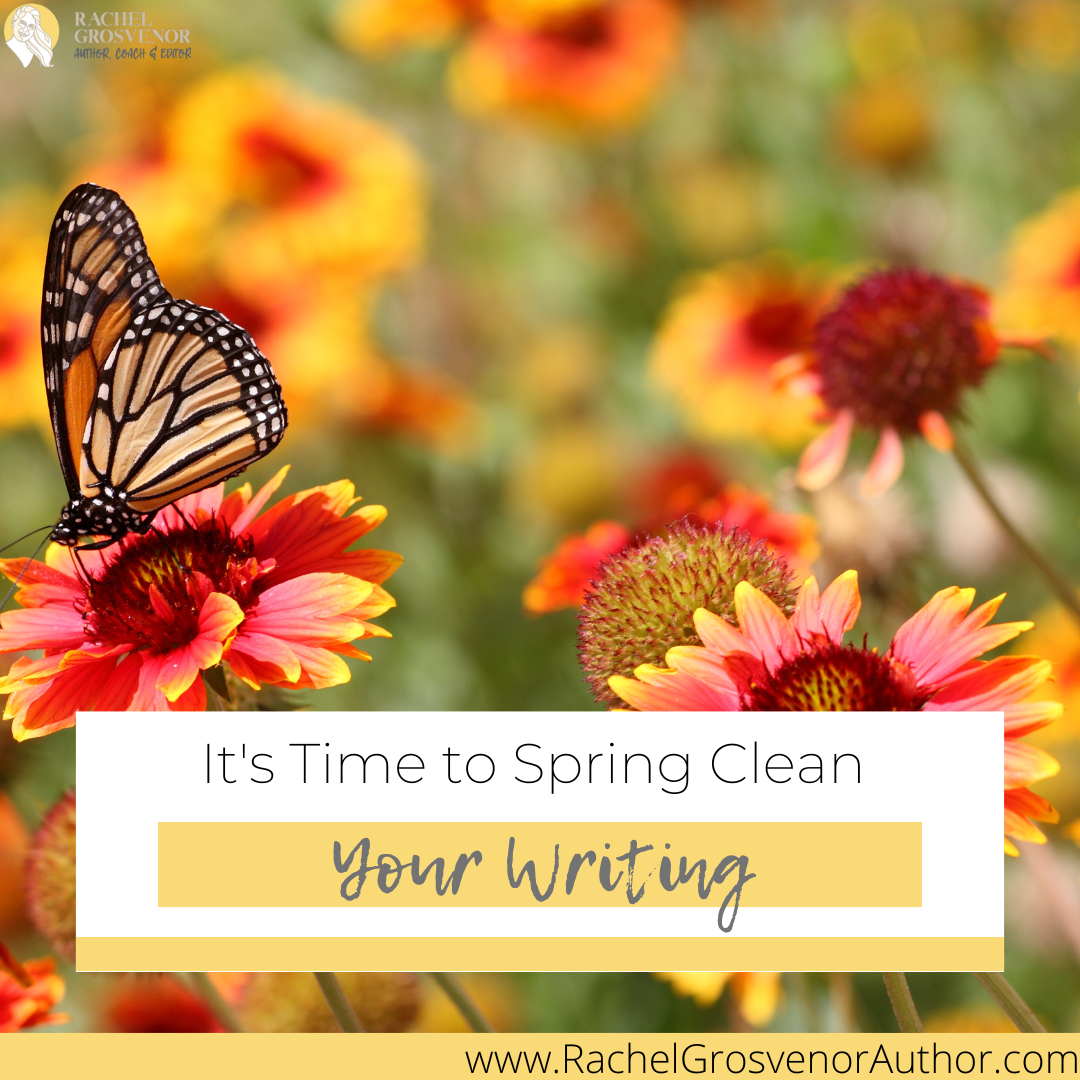Let’s spring clean your writing!
It’s spring cleaning season – so let’s take action and start with your writing (the housework can wait).
We’ll begin with the decluttering.
Remove unnecessary adjectives and adverbs.
A good trick is to search for words ending in ‘-ly’, ‘-ive’, ‘-ous’, or ‘-al’. Obviously not all adjectives and adverbs end in these, but it’s a great way to find them!
Remove filler words and clichés.
Read your work aloud (or have your computer do it for you!). It will help you notice when your pace slows, when filler words appear, and when a predictable phrase or cliché rolls around. You can also ask for someone else to read your work.
Cut down on repetition.
We all have words that we overuse! To help with this, create a word bank. Your word bank will be words or phrases you lean on. In the meantime, check for these common ones: Nodding, smiling, breathing, quietly.
Reduce sentences that aren’t adding to the overall story.
First, check your dialogue for conversation that isn’t driving your narrative forward. Then, check for tangents. Have you gotten caught up in exploring a subplot or description?
Now, let’s freshen up your descriptions!
Use the senses.
Your character is walking through the town in which they live. What does the air smell like? How does it feel on their skin? What can they taste? Create an immersive experience for your reader by engaging their senses, and pull them right into the world you have created.
Get specific.
Avoid generalisations and use comparisons to help a reader understand what you are describing. Your character might be tall, for example, but it’s more powerful to say that they tower over the door of their enemy.
Use setting to reflect emotion.
Tolkien was a master at this – reflecting the emotion of a scene in the setting and atmosphere around the characters. Have a go – if your character is feeling despondent, how might this change how they view the world? Perhaps the once pink sky has now turned grey, the leaves on the trees turning to ash.
Feeling good? It’s time to trim your plot now.
Revisit your timeline.
Are there any inconsistencies? Unnecessary time jumps? Check that you are telling your story in a way that will make sense for the reader. If you spot an inconsistency – don’t panic. You may need to adjust your timeline. For this – write out each chapter in one sentence, and then consider what can stay, what needs moving, whether you want to change what a chapter is about, or even if you want to condense any.
Remove filler scenes.
Are there any scenes that don’t advance your plot or character’s development? Sometimes in drafting, we can indulge in writing that isn’t actually moving the journey on. Review your plot and ask yourself with each chapter – what did this do to move my story forward?
Identify subplots.
Subplots are like chair legs – they need to hold up the main plot! If they don’t, they are their own story. So consider, what are your subplots, and are they all relevant and working for your main plot?
Great work so far. Let’s move on to polishing your dialogue.
Make your character’s voice unique to them.
Consider that even people from the same place don’t speak in the same way. How is your character unique, and how will this change how they talk? As people develop, speech also changes. How will you show your character’s development through their dialogue?
Show, don’t tell.
Use dialogue to reveal emotions – show proof that they are feeling a certain way, instead of telling the reader. For example, show us that your character is angry instead of telling us that they are speaking ‘angrily’. (Need more info on this? See this post here!)
Use contractions.
People rarely say ‘I will not’ instead of ‘I won’t’. Use contractions to make your dialogue more natural and to mirror how people speak in real life.
Remove filler.
Though in reality, we say words such as ‘like’ or ‘um’ when we speak, too much of this in fiction can be jarring for the reader and slows down the pace of a story. Look out for these words in your narrative and remove any that repeat too often.
Phew. Apart from clearing your desk, there is only one task left! Let’s talk about refreshing your perspective as a writer.
Take a step back.
Taking a break can make all the difference. If you’re feeling overwhelmed, confused, or like you don’t know how to make your writing the best it can be, take a break. Take some time to review what’s worked for you too – we can’t move forward successfully unless we review what has and has not worked in the past.
Remember that there is always more to learn.
An education can help you reframe perspective. Engage in new writing groups, opportunities, or courses. Chat to other writers, or subscribe to a writing industry magazine. Engage with your writing community.
Revisit your old work.
How far have you come since you began your writing journey? Reflect on what you have done, where you have grown, and how your skills have improved. Make a note of them, and reward yourself. Being a writer isn’t easy, but you’re doing it!
Set new writing goals.
Try and remove the pressure of the overall ‘I want to write a novel’ goal. It’s too big to work towards, but if you break it down into manageable chunks, you’ll find yourself achieving it more easily. Need more help with this one? Grab The Ultimate Writer’s Planning Workbook! It’ll take you through the entire process.
There you have it writer, you have completed your spring cleaning task! Now it’s time to make a cup of tea and enjoy the warm weather.


